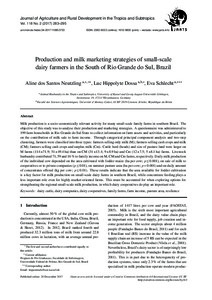| dc.date.accessioned | 2018-01-02T12:47:53Z | |
| dc.date.available | 2018-01-02T12:47:53Z | |
| dc.date.issued | 2017-12-20 | |
| dc.identifier.issn | 1612-9830 | |
| dc.identifier.issn | 2363-6033 | |
| dc.identifier.uri | urn:nbn:de:hebis:34-2017110853733 | |
| dc.identifier.uri | http://hdl.handle.net/123456789/2017110853733 | |
| dc.language.iso | eng | |
| dc.publisher | Kassel University Press | ger |
| dc.rights | Urheberrechtlich geschützt | |
| dc.rights.uri | https://rightsstatements.org/page/InC/1.0/ | |
| dc.subject | dairy cattle | eng |
| dc.subject | dairy companies | eng |
| dc.subject | dairy cooperatives | eng |
| dc.subject | family farms | eng |
| dc.subject | farm income | eng |
| dc.subject | pasture area | eng |
| dc.subject | resilience | eng |
| dc.subject.ddc | 630 | |
| dc.title | Production and milk marketing strategies of small-scale dairy farmers in the South of Rio Grande do Sul, Brazil | eng |
| dc.type | Aufsatz | |
| dcterms.abstract | Milk production is a socio-economically relevant activity for many small-scale family farms in southern Brazil. The objective of this study was to analyse their production and marketing strategies. A questionnaire was administered to 199 farm households in Rio Grande do Sul State to collect information on farm assets and activities, and particularly on the contribution of milk sale to farm income. Through categorical principal component analysis and two-step clustering, farmers were classified into three types: farmers selling only milk (M); farmers selling cash crops and milk (CM); farmers selling cash crops and surplus milk (Cm). Cattle herd (heads) and size of pasture land were larger on M farms (114 ±71.9; 51 ±49.4 ha) than on CM (31 ±13.4; 9 ±8.9 ha) and Cm (12 ±7.5; 5 ±8.1 ha) farms. Livestock husbandry contributed 71, 59 and 16 % to family income on M, CM and Cm farms, respectively. Daily milk production of the individual cow depended on the area cultivated with fodder maize (ha per cow; p ≤ 0.001), on sale of milk to cooperatives or to private companies (p ≤ 0.01), on summer pasture area (ha per cow; p = 0.001) and on daily amount of concentrates offered (kg per cow; p ≤ 0.01). These results indicate that the area available for fodder cultivation is a key factor for milk production on small-scale dairy farms in southern Brazil, while concentrate feeding plays a less important role even for highly market-oriented farms. This must be accounted for when exploring options for strengthening the regional small-scale milk production, in which dairy cooperatives do play an important role. | eng |
| dcterms.accessRights | open access | |
| dcterms.bibliographicCitation | In: Journal of Agriculture and Rural Development in the Tropics and Subtropics. Kassel : Kassel University Press. - Vol. 118, No. 2 (2017) S. 283-295 | |
| dcterms.creator | Neutzling, Aline dos Santos | |
| dcterms.creator | Dossa, Luc Hippolyte | |
| dcterms.creator | Schlecht, Eva | |
| dc.description.everything | Gedruckte Ausg. im Verlag Kassel Univ. Press (www.upress.uni-kassel.de) erschienen. | ger |

